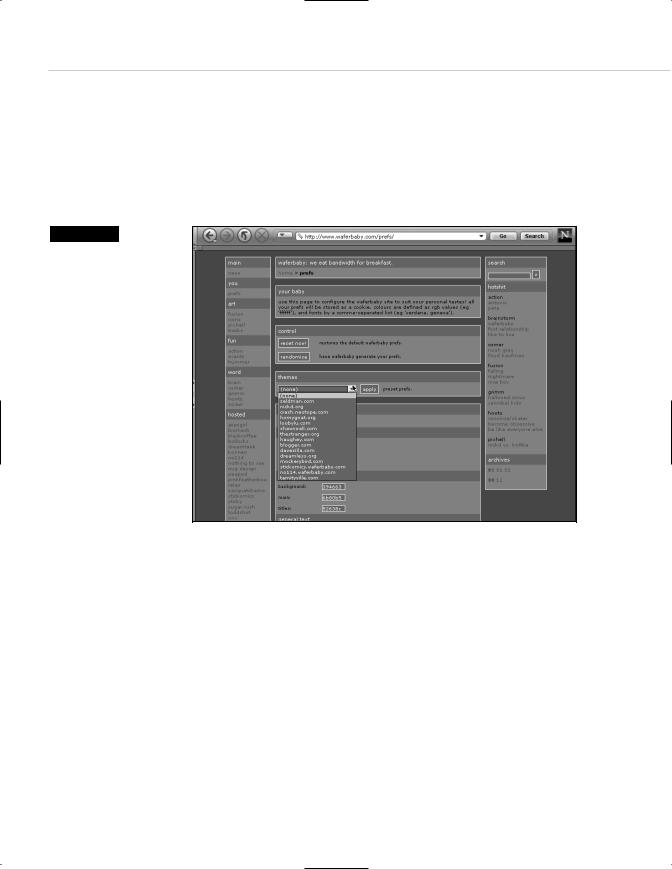
- •Taking Your Talent to the Web
- •Introduction
- •1 Splash Screen
- •Meet the Medium
- •Expanding Horizons
- •Working the Net…Without a Net
- •Smash Your Altars
- •Breath Mint? Or Candy Mint?
- •Where’s the Map?
- •Mars and Venus
- •Web Physics: Action and Interaction
- •Different Purposes, Different Methodologies
- •Web Agnosticism
- •Point #1: The Web Is Platform-Agnostic
- •Point #2: The Web Is Device-Independent
- •The 18-Month Pregnancy
- •Chocolatey Web Goodness
- •’Tis a Gift to Be Simple
- •Democracy, What a Concept
- •Instant Karma
- •The Whole World in Your Hands
- •Just Do It: The Web as Human Activity
- •The Viewer Rules
- •Multimedia: All Talking! All Dancing!
- •The Server Knows
- •It’s the Bandwidth, Stupid
- •Web Pages Have No Secrets
- •The Web Is for Everyone!
- •Swap text and code for images
- •Prune redundancy
- •Cache as Cache Can
- •Much Ado About 5K
- •Screening Room
- •Liquid Design
- •Color My Web
- •Thousands Weep
- •Gamma Gamma Hey!
- •Typography
- •The 97% Solution
- •Points of Distinction
- •Year 2000—Browsers to the Rescue
- •Touch Factor
- •Appropriate Graphic Design
- •User Knowledge
- •What Color Is Your Concept?
- •Business as (Cruel and) Usual
- •The Rise of the Interface Department
- •Form and Function
- •Copycats and Pseudo-Scientists
- •Chaos and Clarity
- •A Design Koan: Interfaces Are a Means too Often Mistaken for an End
- •Universal Body Copy and Other Fictions
- •Interface as Architecture
- •Ten (Okay, Three) Points of Light
- •Be Easily Learned
- •Remain Consistent
- •Continually Provide Feedback
- •GUI, GUI, Chewy, Chewy
- •It’s the Browser, Stupid
- •Clarity Begins at Home (Page)
- •I Think Icon, I Think Icon
- •Structural Labels: Folding the Director’s Chair
- •The Soul of Brevity
- •Hypertext or Hapless Text
- •Scrolling and Clicking Along
- •Stock Options (Providing Alternatives)
- •The So-Called Rule of Five
- •Highlights and Breadcrumbs
- •Consistent Placement
- •Brand That Sucker!
- •Why We Mentioned These Things
- •The year web standards broke, 1
- •The year web standards broke, 2
- •The year web standards broke, 3
- •The year the bubble burst
- •5 The Obligatory Glossary
- •Web Lingo
- •Extranet
- •HTML
- •Hypertext, hyperlinks, and links
- •Internet
- •Intranet
- •JavaScript, ECMAScript, CSS, XML, XHTML, DOM
- •Web page
- •Website
- •Additional terminology
- •Web developer/programmer
- •Project manager
- •Systems administrator (sysadmin) and network administrator (netadmin)
- •Web technician
- •Your Role in the Web
- •Look and feel
- •Business-to-business
- •Business-to-consumer
- •Solve Communication Problems
- •Brand identity
- •Restrictions of the Medium
- •Technology
- •Works with team members
- •Visually and emotionally engaging
- •Easy to navigate
- •Compatible with visitors’ needs
- •Accessible to a wide variety of web browsers and other devices
- •Can You Handle It?
- •What Is the Life Cycle?
- •Why Have a Method?
- •We Never Forget a Phase
- •Analysis (or “Talking to the Client”)
- •The early phase
- •Design
- •Brainstorm and problem solve
- •Translate needs into solutions
- •Sell ideas to the client
- •Identify color comps
- •Create color comps/proof of concept
- •Present color comps and proof of concept
- •Receive design approval
- •Development
- •Create all color comps
- •Communicate functionality
- •Work with templates
- •Design for easy maintenance
- •Testing
- •Deployment
- •The updating game
- •Create and provide documentation and style guides
- •Provide client training
- •Learn about your client’s methods
- •Work the Process
- •Code Wars
- •Table Talk
- •XHTML Marks the Spot
- •Minding Your <p>’s and q’s
- •Looking Ahead
- •Getting Started
- •View Source
- •A Netscape Bonus
- •The Mother of All View Source Tricks
- •Doin’ it in Netscape
- •Doin’ it in Internet Explorer
- •Absolutely Speaking, It’s All Relative
- •What Is Good Markup?
- •What Is Sensible Markup?
- •HTML as a Design Tool
- •The Frames of Hazard
- •Please Frame Safely
- •Framing Your Art
- •<META> <META> Hiney Ho!
- •Search Me
- •Take a (Re)Load Off
- •WYSIWYG, My Aunt Moira’s Left Foot
- •Code of Dishonor
- •WYS Is Not Necessarily WYG
- •Publish That Sucker!
- •HTMHell
- •9 Visual Tools
- •Photoshop Basics: An Overview
- •Comp Preparation
- •Dealing with Color Palettes
- •Exporting to Web-Friendly Formats
- •Gamma Compensation
- •Preparing Typography
- •Slicing and Dicing
- •Rollovers (Image Swapping)
- •GIF Animation
- •Create Seamless Background Patterns (Tiles)
- •Color My Web: Romancing the Cube
- •Dither Me This
- •Death of the Web-Safe Color Palette?
- •A Hex on Both Your Houses
- •Was Blind, but Now I See
- •From Theory to Practice
- •Format This: GIFs, JPEGs, and Such
- •Loves logos, typography, and long walks in the woods
- •GIFs in Photoshop
- •JPEG, the Other White Meat
- •Optimizing GIFs and JPEGs
- •Expanding on Compression
- •Make your JPEGS smaller
- •Combining sharp and blurry
- •Animated GIFs
- •Creating Animations in ImageReady
- •Typography
- •The ABCs of Web Type
- •Anti-Aliasing
- •Specifying Anti-Aliasing for Type
- •General tips
- •General Hints on Type
- •The Sans of Time
- •Space Patrol
- •Lest We Fail to Repeat Ourselves
- •Accessibility, Thy Name Is Text
- •Slicing and Dicing
- •Thinking Semantically
- •Tag Soup and Crackers
- •CSS to the Rescue…Sort of
- •Separation of Style from Content
- •CSS Advantages: Short Term
- •CSS Advantages: Long Term
- •Compatibility Problems: An Overview
- •Working with Style Sheets
- •Types of Style Sheets
- •External style sheets
- •Embedding a style sheet
- •Adding styles inline
- •Fear of Style Sheets: CSS and Layout
- •Fear of Style Sheets: CSS and Typography
- •Promise and performance
- •Font Size Challenges
- •Points of contention
- •Point of no return: browsers of the year 2000
- •Absolute size keywords
- •Relative keywords
- •Length units
- •Percentage units
- •Looking Forward
- •11 The Joy of JavaScript
- •What Is This Thing Called JavaScript?
- •The Web Before JavaScript
- •JavaScript, Yesterday and Today
- •Sounds Great, but I’m an Artist. Do I Really Have to Learn This Stuff?
- •Educating Rita About JavaScript
- •Don’t Panic!
- •JavaScript Basics for Web Designers
- •The Dreaded Text Rollover
- •The Event Handler Horizon
- •Status Quo
- •A Cautionary Note
- •Kids, Try This at Home
- •The Not-So-Fine Print
- •The Ever-Popular Image Rollover
- •A Rollover Script from Project Cool
- •Windows on the World
- •Get Your <HEAD> Together
- •Avoiding the Heartbreak of Linkitis
- •Browser Compensation
- •JavaScript to the Rescue!
- •Location, location, location
- •Watching the Detection
- •Going Global with JavaScript
- •Learning More
- •12 Beyond Text/Pictures
- •You Can Never Be Too Rich Media
- •Server-Side Stuff
- •Where were you in ‘82?
- •Indiana Jones and the template of doom
- •Serving the project
- •Doing More
- •Mini-Case Study: Waferbaby.com
- •Any Size Kid Can Play
- •Take a Walk on the Server Side
- •Are You Being Served?
- •Advantages of SSI
- •Disadvantages of SSI
- •Cookin’ with Java
- •Ghost in the Virtual Machine
- •Java Woes
- •Java Woes: The Politically Correct Version
- •Java Joys
- •Rich Media: Exploding the “Page”
- •Virtual Reality Modeling Language (VRML)
- •SVG and SMIL
- •SMIL (through your fear and sorrow)
- •Romancing the logo
- •Sounds dandy, but will it work?
- •Promises, Promises
- •Turn on, Tune in, Plug-in
- •A Hideous Breach of Reality
- •The ubiquity of plug-ins
- •The Impossible Lightness of Plug-ins
- •Plug-ins Most Likely to Succeed
- •Making It Work: Providing Options
- •The “Automagic Redirect”
- •The iron-plated sound console from Hell
- •The Trouble with Plug-ins
- •If Plug-ins Run Free
- •Parting Sermon
- •13 Never Can Say Goodbye
- •Separation Anxiety
- •A List Apart
- •Astounding Websites
- •The Babble List
- •Dreamless
- •Evolt
- •Redcricket
- •Webdesign-l
- •When All Else Fails
- •Design, Programming, Content
- •The Big Kahunas
- •Beauty and Inspiration
- •Index

Taking Your Talent to the Web |
335 |
Some web designers understand this as part of the discipline of the craft and strive to bring beauty, elegance, and utility to their simple designs. Others rebel and might be temperamentally unsuited to this type of work. The Web needs both kinds of designers, and there is plenty of work for both.
The need for simplicity is another reason that it’s best to do as much of the design work as possible in CSS (as long as the middleware doesn’t choke on it). There is little sense in asking the server to generate deeply nested table cells when you can achieve the same result with light, clean, structural markup and a single declaration in a global style sheet. By doing the work in CSS, you save processor cycles and bandwidth; and when it comes time to update the design, you can do it yourself in the style sheet instead of pestering the programmers to change their scripts.
Naturally, you will have to test to make sure that the middleware your company has chosen can handle the CSS you’ve written. You’ll also have to test the site in multiple browsers, as described in Chapter 7, “Riding the Project Life Cycle.” During testing, you also will want to turn off CSS in your browsers to make sure that the resulting pages work in non-CSS browsers (or in CSS browsers whose users have turned off CSS in their preferences).
What do we mean by “make sure the pages work with CSS turned off?" We mean that the pages work. We don’t mean that the pages look the same with CSS and without it. Bad clients and stupid companies expect sites to look exactly the same in AOL 1.0 and Netscape 6. That’s impossible without quadrupling the budget, and it’s also pointless. Those who turn off CSS or use older browsers aren’t hoping for a rich visual experience. If you stick with basic structural markup and the simple CSS techniques described in Chapter 10, “Style Sheets for Designers,” you should be fine.
DOING MORE
Coding in PHP or ASP rarely falls within the web designer’s job description, but after working in the field for a while, many web designers are pleased to discover that they have a knack for these simple programming environments. If you are one of them, this knack will not go unappreciated or make you any less marketable.

336 HOW: Beyond Text/Pictures: Doing More
Mini-Case Study: Waferbaby.com
Waferbaby (http://www.waferbaby.com/), Daniel Bogan’s delightful, personal site, makes smart use of PHP to facilitate dynamic content such as the site’s “Brainstorm” section and to enable playfully user-centric design, as seen in the site’s “Preferences” department (see Figure 12.3).
Figure 12.3
User-selectable “Preferences” at Daniel Bogan’s Waferbaby. Choose a look, and the site changes. Though this might appear to be the brainchild of a pro-
grammer, Bogan is actually an animator-illustrator.
If he can do it, you can do it (http:// www.waferbaby.com/).
In “Brainstorm,” readers respond to a provocative question on the site by typing their answers in a form. Instantly, these answers appear on the page, in reverse chronological order. Readers vie to outdo the wit and originality of previous answers. The audience creates the content; personal involvement and natural curiosity promote repeat visits.
In “Preferences,” visitors can modify Waferbaby’s appearance by choosing alternate color schemes and typographic choices modeled after wellknown personal sites or create their own look and feel by editing a CSS document right in the browser. When the reader is happy with the color scheme and typography, it is stored as a JavaScript cookie on her hard drive. The site will use her chosen color scheme and fonts until she decides to change it.

Taking Your Talent to the Web |
337 |
Both “Brainstorm” and “Preferences” are made possible by a few lines of code in PHP, a JavaScript cookie, and a MySQL database to store and fetch the results.
Mini-Case Study: Metafilter.com
In 1999, Matt Haughey used Allaire Cold Fusion to create Metafilter (http:// www.metafilter.com/), a community site for web authors who like to write about other people’s web content. This site will be discussed again in Chapter 13. For the time being, it is worth noting how Metafilter accommodates two levels of dynamic change: instantaneous change based on user actions and evolutionary change based on user patterns observed over time (see Figure 12.4).
Figure 12.4
Matt Haughey’s Metafilter community site, a webbased application that responds to its members’ needs. The dark blue panel at right, introduced in January 2001, keeps members posted on changes in the way the site functions (http://www.metafilter.com/).
As in Waferbaby’s “Brainstorm,” at Metafilter, user participation fashions the content, generating loyalty and repeat usage. As usage patterns emerge, Haughey responds to them by adjusting the way the site works. A new feature is added, an old one removed. This in turn changes the way the site is perceived and used. New usage patterns emerge, and over time, new site-wide changes are instituted.

338 HOW: Beyond Text/Pictures: Doing More
Every site owner studies usage patterns and changes the site accordingly: rotating content more frequently in the most visited sections; clarifying a text label if one section of the site continually goes ignored; changing the design to emphasize the least-visited section (or the most-visited); or removing front page links to sections the public simply seems not to care about (but keeping those sections alive to avoid link rot). The possibilities are many.
Add dynamic, user-generated content to the mix, and the potential grows even more interesting. On top of everything else, a psychological dynamic begins to emerge. Is the community shaping the site, or is the site shaping the community?
We don’t wish to imply that this whole thing goes on like a scientific experiment or that the community in question serves as some kind of Petri dish slide. As in any good community site, the owner/moderator is as involved as any other member—but with the added ability to institute changes or solicit suggested changes from the members. What is interesting is the way that human dynamic behavior shapes and is shaped by basic web dynamism. This is the power of a site that changes when you type on it.
This is interactivity print cannot match.
Any Size Kid Can Play
We’ve confined our case studies to two relatively small-scale (but influential) projects to show that dynamic interactivity is within the reach of even the modest web shop or the lone freelancer. Large-scale projects require teams of information architects, project managers, web designers, developers, writers, web technicians, producers, network administrators, server consultants, marketers, advertising teams, editors, and content specialists. If you go into full-time web design, you will likely be part of such enterprises. But even sites created by tiny teams can use the techniques just discussed to add web dynamism to the mix.
For instance, a dyed-in-the-wool print designer wishes to service a few of his clients who’ve requested smallish websites: 10 to 20 pages of mostly static content. One of these clients urgently desires the ability to post cus-
